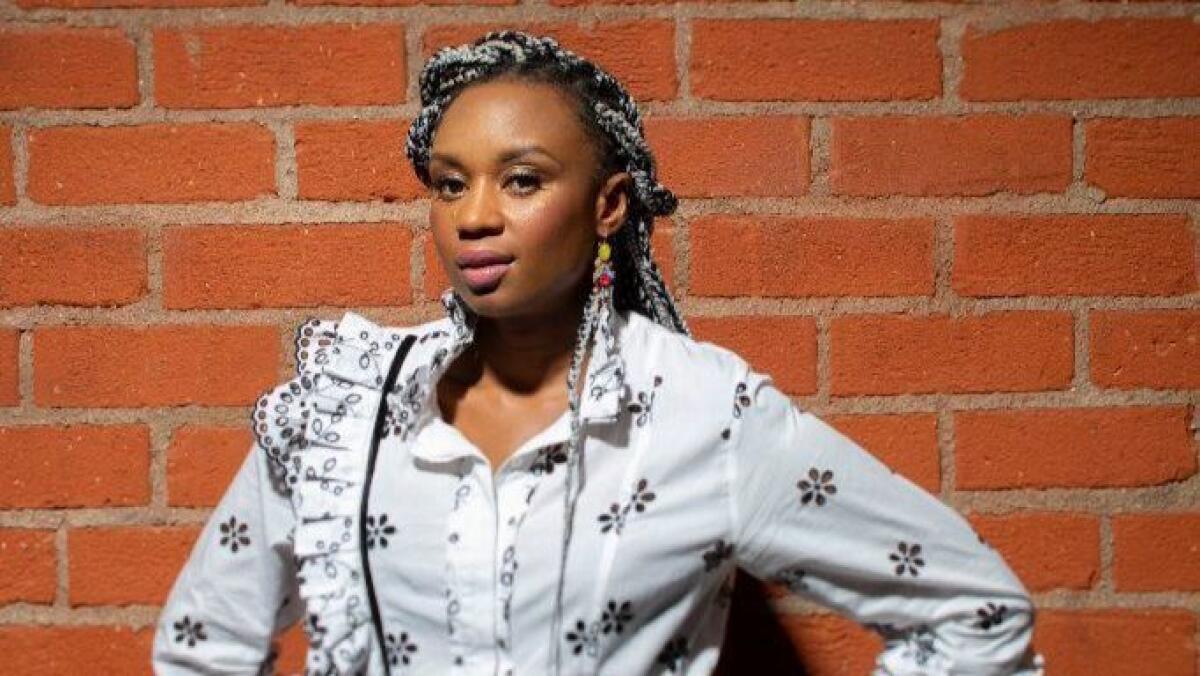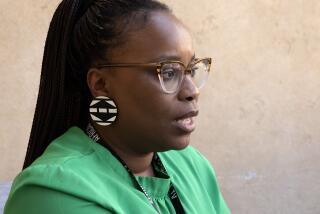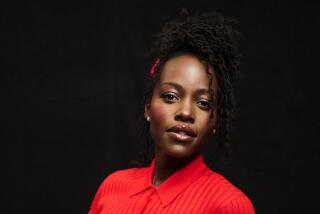Q&A: Kenyan director Wanuri Kahiu on her once-banned film ‘Rafiki’: ‘I know that I’m created to work’

The first time Wanuri Kahiu remembers seeing African people onscreen falling in love was when she was a teenager.
“Americans were falling in love and Europeans were falling in love,” she said, “but Africans, we were never falling in love. The first time I saw an African couple even hold hands on screen, I was 16.”
So for her second feature as a writer-director (following her 2009 debut “From a Whisper”), the Nairobi, Kenya-born filmmaker “wanted to be able to tell a love story about us.
“I just wanted to see ourselves fall in love,” she said.
Kahiu found that opportunity in “Rafiki,” an adaptation of Ugandan writer Monica Arac de Nyeko’s short story “Jambula Tree,” which was awarded the prestigious Caine Prize for African Writing in 2007. The 90-minute drama follows two teenage girls (Samantha Mugatsia and Sheila Munyiva) whose love for each other is opposed by their families and communities.
Ahead of the picture’s AFI Fest screenings on Sunday and Wednesday, Kahiu spoke to The Times via phone from New Zealand about “Rafiki,” its initial ban in her home country and the enduring message of the film — even though it wasn’t selected as Kenya’s official Academy Awards submission.
The film centers on a queer relationship between two girls in a country that, from the outside looking in, isn’t the safest for lesbian, gay, bisexual and transgender people. Did that give you any pause in the start?
No. From the moment I read it, I knew that it would be a bit of a challenge, but love is love so I wasn’t concerned about it at all. The story itself was written by a Ugandan writer and set in Uganda, so it didn’t seem like it was [a problem] ... and now we’re over 11 years after it was written. I knew it’d be a challenge, but I didn’t think it’d be as major as it became.
Though initially banned by Kenyan authorities, the film received a weeklong theatrical run after you sued on the basis of an infringement on freedom of expression and free speech. Why was it important to sue the Kenyan government in order to allow people to have access to this film?
Whenever somebody stands in your way and tells you your work is not valid or your work cannot be seen, they start to interfere with your very basic rights to work. And I know that I’m created to work. Past this film, I don’t know what other issues the Kenyan film classification board would have with the work that I create. So it was beginning to be an untenable situation for me to continue to work in Kenya, which I want to be able to do. And to be able to work in Kenya, I needed to go to court and say, “You’re stopping my ability to work.” Also this idea of a limitation of imagination or telling people what they can imagine and what they cannot imagine, it didn’t sit well.
On top of that, thinking about any young artists who are watching this sense of discrimination that was happening to our projects — and the words that were used to describe me personally and my work — was not right. I can’t imagine what it would be like for other artists coming up and them watching another artist be silenced. It’s not an environment that fosters a robust culture and it’s just something that was really frustrating and painful. I needed to say something, and luckily there was a group of artists who call themselves a creative economy working, and together we pushed back.
This idea of a limitation of imagination or telling people what they can imagine and what they cannot imagine, it didn’t sit well.
— “Rafiki” director Wanuri Kahiu on her initial reaction to her film being banned in Kenya
You’ve described the film as “Afro Bubblegum.” What do you mean by that?
Afro Bubblegum is art and culture from Africa and people of color, and it just has hope and joy at the center of it. It’s incredibly important to me to show images of hope and joy because, apart from what we’re known to be in media and in films, which is people who are always struggling and seeking survival, I feel like we needed to show ourselves as people of joy and people in pursuit of happiness. And that’s why we started to define work as Afro Bubblegum. And it’s not just myself but other artists who started to do that. Then what happened is, the moment you started to speak “Afro Bubblegum” into the world, other artists started to do the same.
And how do you think that shows up in “Rafiki”? I know there were a lot more bright colors than I expected.
I chose to show Afro Bubblegum in the story and making sure there is a sense of the girls falling in love. But also the color pattern was one that we used to explain the joy and the metaphor of love that was in the girls’ lives, and it was important to use those colors in that way. The music is also quite Afro Bubblegum in its selection. It was very fresh and fun.
The film was the first from Kenya to ever premiere at Cannes, and it’s since been winning a lot of awards on the festival circuit. What does it mean to see the film is being well received by all of these different audiences?
I think it’s great, and it’s extraordinary how people feel seen by watching the movie ... and they feel like they’re acknowledged. And I think that’s the power of film. The strongest thing that has resonated is the young LGBT community who flock to the film, who understand it, who love it, and who are using it in Kenya. A lot of people use it to talk to their parents about coming out.
In the one week that it showed in Kenya, it did a remarkable amount for the young LGBT community there because they were able to use it as a jump-off; they were able to celebrate their own life, their own love. And they were able to start conversations with their parents. That was huge and such a beautiful, beautiful, beautiful, beautiful thing … I never could have foreseen the things that this film has done, not only for myself, but for the audiences who have watched it.
What other responses have you seen the film spark back home?
It also started conversations with the more conservative people in society in terms of the existence of different types of love, which is very wonderful. I see the effects of that in my own family. I see an openness to have conversations where once conversations were incredibly difficult. So that’s the progress that I see. But also, it’s part of a larger conversation of what we are allowed to say, a conversation about freedom of expression, which is one that hasn’t been had before because though our constitution allows freedom of expression, freedom of creativity, it’s never been tested.
This is the first time we’re testing the constitution and saying, “Well if this is what the constitution says, why are we still using colonial laws to ban and censor when our constitution supersedes any laws that were made before it?” It’s a great time to start unpacking the conversations about who we are as a democratic society and what information we should have access to.
What does that response tell you about the film appetite of audiences in Kenya?
I think that, like any other audience, we’re all looking for a story, something we can watch and see ourselves [in]. The idea of representation has never been more important than now because we have the ability to see ourselves. But anytime that we are denied our ability to see ourselves the way we want to see ourselves is an infringement on our rights to be able to participate in a meaningful way with culture and with arts.
When the ban was lifted and we sold out theaters for the seven days that the film played, it really reinforced the [need for] the kind of stories that we want to be able to see of ourselves. We want to see good friends, we want to see good stories and we want to see ourselves in love sometimes, as well as enjoying every different situation. With the right kind of marketing and the right kind of push and the right kind of stories, I think that data is beginning to show that we can also contribute to box office — which is exactly what happened with “Black Panther.” “Black Panther” realized the new audiences and I think that films done right can do the same thing.
As “Rafiki” continues to be received worldwide, and up next at AFI Fest, what do you hope audiences are taking away from it?
I have to first acknowledge that it is so great that it is being seen in L.A. I attended UCLA at the film school, so for this film to be watched in L.A. feels like it is coming back to its second home. … I am so, so grateful for that.
I would like the feeling of falling in love to resonate with the audience. No matter where we come from in the world, we all fall in love the same way. We’re all awkward. We’re all shy. We’re all full of angst. We’re all silly and we all laugh and giggle in the same way all around the world when we fall in love. And this is just my contribution to us falling in love, to humanity falling in love.
More to Read
Only good movies
Get the Indie Focus newsletter, Mark Olsen's weekly guide to the world of cinema.
You may occasionally receive promotional content from the Los Angeles Times.











